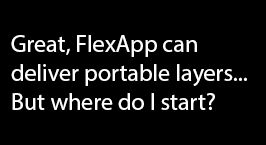Application Layering has finally come of age. We recently delivered our second generation of FlexApp technology in ProfileUnity with FlexApp v6.5. The new filter driver based approach makes FlexApp more compatible with more desktops than ever before including persistent virtual and physical desktops.
If you are a first time user of Application Layering technology you may be overwhelmed by the choices, you may also be wondering, “which applications should I start with?” In short, just about any application that does not require full application isolation is an GOOD candidate for FlexApp Layering so your options are nearly limitless. However, there are applications that may be more of a pain to manage and maintain than others. These are GREAT candidates for FlexApp. The three types of applications below are suggested starting points that will immediately make your life easier:
- Applications with Frequent Updates
- Applications that need a DR/HA plan (core / key apps at a minimum)
- Applications that require faster storage I/O for better performance
Many companies have invested in user data and server system replication. This is not the case for VM desktop images as they are abundant and large. Below is a sample of the key points with some basic methods to accomplish both tasks. Only the Liquidware Labs FlexApp method may be feasible for many. The traditional methods below are greatly simplified in this writing.
Keep in mind the below options for FlexApp Layers are not something that can be done with full desktop layering vendors that follows traditional method, are virtual only, require rebuilding/recomposing when changes to layers are performed. In many cases these applications also cannot be layered with poorly designed layering solutions which have a lot of overhead (SQL backend – often time 1 single layer which is huge and similar to traditional method / not specific to a single application).
FlexApp Layering can be used on virtual and physical systems with only a generic Windows OS needing to be there. And FlexApp does not require a SQL server backend – you only need to copy, paste and import our FlexApps. This can be an automated function with minimal administrative interaction. What we have here is impossible for others today!
FlexApps are portable layers that can be copied, pasted, imported and delivered to virtual and physical desktops today! Here is more detail on three different types of applications you can get started with today.
- Application that require frequent updates
It is very difficult for administrators to update virtual desktops – even for single / small application update. Any update no matter how small, require the ENTIRE image to be recomposed or redeployed out to each data store. There are typically many data stores that host images and recomposing is a dreaded necessity.  Applications typically have to be installed and updated into EACH image when the same application is used by different groups and pools.
Traditional VM method: (approx. method – other methods may exist)
- Open Source Base Image / VM, Update Application, Recompose / Redeploy whole image. (making a mistake is not an option)
- Proceed to do this for all the images and pools that contain the application. (usually many more than 1)
- Takes a significant amount of time to recompose images. (can take all weekend for some)
- Takes a significant amount of resources to recompose. Ie. Can bring the SAN and / or network link “to its knees” (can crush performance on anything SAN/NAS and network attached)
- Most of the time this has to be done with users offline
- Must be done to each image and each pool the application is used with
Liquidware Labs FlexApp method
- Update the single application in the FlexApp packaging console (either clone, update and reassign or extend the in-use package – basically push button in our console)
- Can be done during the workday – even at peak usage without user disruption
- This is done once vs. once for each image or pool / Package once and deploy many
- Application can be copied, imported and deployed to more users for scaling
- No expensive re-compose or rebuilding of images
- Applications that require a DR strategy
Many line of business applications need to be highly available. Usually 100% of the applications do not need to be available, but a core set is required for the main functions of a company to operate.  Images are large and in-use so replicating whole VM images is almost a non-starter for small businesses, even large enterprises. The technical challenges, resource requirements and laws of physics make this impossible for many. Replicating user data is enough to try and manage – much less entire virtual desktop images.
Traditional VM Method: (approx. method – other methods may exist)
- Have 2 datacenters with the exact same desktop images on each end and perform application updates using the traditional application update method in scenario 1 above to primary and secondary locations.
- Consumes lots of people time
- Hard process to execute and to ensure is done exactly the same on both ends
- Invest in significant bandwidth, hardware, software and personal to manage VM desktop image replication. (non-starter for many!)
- Huge investment
- Resource intensive
- Plagued with complexity and failures
Liquidware Labs FlexApp Method:
- Copy the FlexApps from location A to location B. (copy, paste, script or replicate – many options available and single apps are FAR less heavy to copy or replicate than entire VM Images!)
- Import the applications to FlexApp
- Assign the application with ProU to virtual or physical desktops!  (It’s not required to have the same virtual desktops at the DR location!)
- Applications that require higher I/O than your SAN / NAS can deliver
Â
Often times SAN/NAS systems are overloaded mechanically, on the network – even the built-in caching systems of these devices are taxed to the max trying to optimize and deliver the entire VM image. Decoupling applications from the image and delivering them from new or alternate storage can be next to impossible for many applications using traditional application virtualization. The performance overhead of traditional application virtualization (in the bubble isolated apps using ThinApp or App-V) is often used for application compatibility and never for higher performance.
Traditional Method (approx. method – other methods may exist)
- Move entire image to faster, less loaded SAN or NAS
- Upgrade entire SAN / NAS volume (Significant investment and may not give boost to specific apps)
- Implement I/O acceleration in memory technology (some are complex and expensive and not application specific – Flex-IO being the easiest and least expensive but not always possible for diverse image pools or persistent VM desktops)
Liquidware Labs FlexApp method
- Place FlexApps on higher performing storage (can be done per app with specific focus, application appears to the OS as it’s baked into the original image)
- FlexApp can be delivered from the appropriate VMDK based or VHD based delivery mechanism (Mix and Match)
- Liquidware Labs Flex-IO (or another IOPS acceleration technology such as Atlantis ILIO) can be used on top of vSphere storage volumes hosting FlexApps. (Requires less memory vs a whole VM image, can be focused per application with greatest need, can reduce network utilization)
The types of applications that you can FlexApp are endless but the three types above will give you a great place to start to ease your frustrations of application management immediately. If you are not yet a FlexApp customer, you can download and trial FlexApp today by visiting the Download section of www.LiquidwareLabs.com today.










[…] Check out the rest of the article her at Liquidware labs Blog Click Here […]
[…] Read the entire article here, FlexApp Application Layering is Beyond Cool! But Where Do I Start? […]
[…] Read the entire article here, FlexApp Application Layering is Beyond Cool! But Where Do I Start? […]